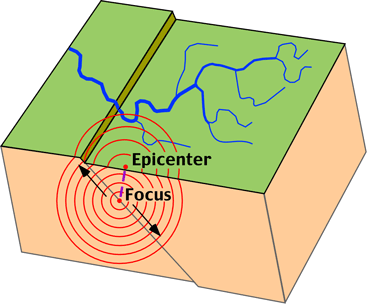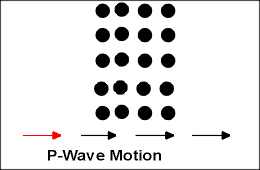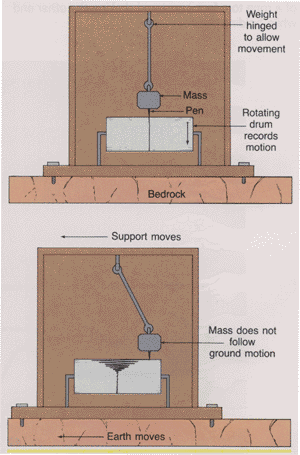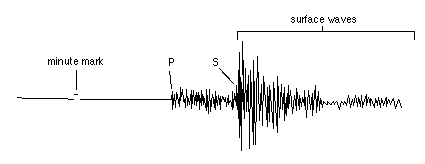
EARTHQUAKES
Chapter 8. notes
An earthquake is a
trembling or shaking of the ground caused by the sudden release of energy stored
in the rocks beneath the earth’s surface.
Elastic rebound theory
(Reid)
1.rock with stress
acting on it
2.Stress hava
caused strain in the rock. Strain builds up for a long period of time, until the
strain gets beyond the rock’s braking point.
3. Rocks brake
suddenly, releasing energy with rock movement along a fault. They can move
horizontally or vertically. Energy release happens in the form of seismic waves.
Seismic waves

After:http://www.geog.ouc.bc.ca/physgeog/contents/10m.html
The point within
the earth where seismic waves originate is called the focus of the
earthquakes. This is the center of the earthquake, the point of the initial
movement along the fault.
EPICENTER:
Is the point on
the earth’s surface directly above the focus.
There are two types of
seismic waves:
1. BODY WAVES:
These waves are
traveling through the earth’s interior spreading from the focus in every
direction (like sound waves in air).
There are two
kind:
a. P WAVE
(primary)
is a
compressional (longitudinal) in which the wave travels parallel to the direction
of wave propagation. This is a very fast wave traveling with 4-7 km/sec speed.
Because it is fast usually this is the first (primary) wave to arrive to a
recording station after an earthquake.

After: http://www.educ.uvic.ca/Faculty/jtinney/earth%20science/Earthq.html#Earthquake
S WAVE
(secondary)
It is slower,
Transfer wave that travels 2-5 km/ sec. An S wave is propagates by a shearing
motion, much like a shaken rope. The rock vibrates perpendicular to the wave
direction.

After: http://www.educ.uvic.ca/Faculty/jtinney/earth%20science/Earthq.html#Earthquake
They both pass
easily through solid rocks, however S wave can not pass through fluid. They are
usually faster in dense rock and slower in unconsolidated sediments.
SURFACE WAVES
They travel on the
surface away from the epicenter (like water waves if we throw a pebble into the
water. They are slow waves, but they cause all the damage, because they cause
ground movement, and since they are slow it takes longer to pass through.
LOCATION AND MEASURING
EARTHQUAKES
Seismograph
Is the equipment which are able to record of the earth motion usually in the form of wiggle line drawn on a strip of paper.

After:http://www.geo.mtu.edu/UPSeis/locating.html
The paper record
is called SEISMOGRAM.

After:http://www.geo.mtu.edu/UPSeis/locating.html
There is a network
of seismographs throughout the earth to record and study earthquakes. (also
nuclear bomb explosions)
Within minutes
after an earthquake happen somewhere distant seismographs begin to pick up
seismic waves. A large one would be detected everywhere on the earth.
Because of the
difference in the speed of the different waves, people can locate earthquakes,
and also study their strength and effects.

After:http://www.geo.mtu.edu/UPSeis/locating.html
Determination
of the earthquake location
Seismogram tells
how fare the earthquake happened, but does not give direction.

Depth of the
earthquakes
The max. depth is
670 km. They are classified into three groups.
1. Shallow
0-70 km 85%
2. intermediate
focus 70-350 km 12%
3. Deep
focus 350-700 km 3%
The shallow focus
quakes are more common, because rocks are more brittle on the surface.
EARTHQUAKE STRENGTH
The strength or
size of the earthquake is measured in two ways
1.
INTENSITY
This is a measure
of the damage caused by the earthquake on humans and buildings.
Intensities are pressed in roman numerals I-XII on the modified MERCALLI SCALE, where higher numbers indicate more damage.
VI. everybody
feels it, the are scared run 0utdoors (damaged chimneys)
VII. Damage
slight. Partial collapse in weak badly designed buildings
VIII. Damage
slight in well designed building, worse in poorly designed ones. so on.
XII. damage is
total.
There is a problem with using this scale, because it is only measures the amount of damage caused in human structures, and there is big difference in building designs. Underlying geology is also important. Houses built on solid rocks are much better for surviving than unconsolidated sediment.
2. MAGNITUDE SCALE
The second method
is to measure the Magnitude of an earthquake (RICHTER SCALE). In
this method people calculate the energy released during the quake. People are
measuring the amplitude of one of the wiggles on the seismogram (commonly used
in the US). After measuring the wiggle amplitude and correcting for the distance
and the specific seismograph, scientist can assign a number called MAGNITUDE.
|
Richter Scale |
Energy Released |
Comment |
|
2.0 |
6.3 x 10 7 |
Smallest earthquake detectable by people. |
|
5.0 |
2.0 x 10 12 |
Energy released by the Hiroshima atomic bomb. |
|
6.0 - 6.9 |
6.3 x 1013 |
About 120 shallow earthquakes of this magnitude occur each year. |
|
6.7 |
7.1 x 1014 |
Northridge, California earthquake 1994. |
|
7.0 |
2.0 x 1015 |
Major earthquake. |
|
7.4 |
7.9 x 1015 |
Turkey earthquake August 17, 1999. More than 12,000 people killed. |
|
7.6 |
1.6 x 1016 |
Deadliest earthquake this century. Tangshan, China, 1976. About 250,000 people died. |
|
8.3 |
1.8 x 1017 |
San Francisco earthquake of 1906. |
|
8.6 |
5.0 x 1017 |
Most powerful earthquake recorded in the last 100 years. Southern Chile 1960. Claimed 5,700 lives. |
The richter scale
goes from 1 -8.6, and there is no upper limit. It is a logarithmic scale the
difference between 1 and 2 is ten times. Earthquake with larger amplitude than 9
is unlikely to occur because it seems that this is the upper limit of elastic
strength beyond which rocks will brake.
Erathquakes in USA
Only a few
location are earthquake free.
Most of the large
earthquakes occur in the western part of the US.
EFFECT OF EARTHQUAKES
1.GROUND MOTION
This is the
trembling and shaking of the land that can cause the buildings to vibrate. In
large quakes the motion is visible.
Because proper
building construction can reduce the damage in a great deal, building codes has
to be very strict in special areas. Their location also has to be controlled.
(hard rock!)
2.FIRE
Particularly
serious problem after an earthquake, because of the frequently broken gas and
water pipes, and fallen electrical wires.
3.LANDSLIDES
They can be
triggered by shaking the ground (1959 Madison Canyon) 1970 Peru huge mud flows
in the Andes!!
4. PERMANENT
DISPLACEMENT OF THE SURFACE
5.AFTERSHOCKS
Small earthquakes following the big ones. Although they are smaller they still can cause damage in the weakened constructions.
6. TSUNAMIS
Seaquake; initiate
huge wave.... (seismic sea waves) Hurricane can have a wavelength of 400 m,
however a tsunami may have a wavelength of 100 miles and may be moving
450 miles/hour. The wave height near the shore can be 15-30 m.
Because of the
long wavelength of the tsunamis it will not withdraw fast, but the water will
rise for 5-10 minutes, causing flood.
7. LIQUEFACTION
In areas where
unconsolidated sediment ids water filled, during the quake the sediment turns
into liquid that is not capable to support buildings. Buildings will collapse an
sewage tanks and other underground constructions will float up to the surface.
DISTRIBUTION OF
EARTHQUAKES
Related to plate boundaries most of the time
EARTHQUAKE
PREDICTION
-MONITORING OF
SLIGHT CHANGES ALONG FAULT ZONES.
-BEFORE LARGE
QUAKES, SMALL CRACKS CAN FORM ALONG THESE ZONES; THE PROPERTIES THE ROCKS CAN BE
CHANGED, BECAUSE OF THE SMALL CRACKS.
-WATER LEVELS IN
WELLS MAY RISE
-SURFACE OF THE
EARTH TILTS AND SLIGHTLY CHANGES ELEVATION
-CHINESE
SCIENTISTS CLAIM PREDICTION BASED ON ANIMAL BEHAVIORS: HORSES BECAME SKITTISH,
SNAKES LIVE THEIR HOLES
(IN 1975 CHINESE
PREDICTED AN EARTHQUAKE 5 HOURS BEFORE)